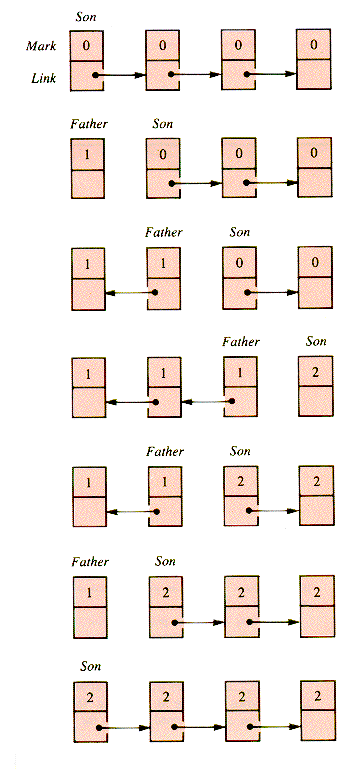



One technique that is helpful for working through the maze of links of a general list is to mark processed nodes, as done in Rvisit (section 7.7). It is convenient to cycle through the paths generated by Link[1] ... Link[n] by making Mark an integer: Mark = 0 for an unprocessed node and Mark = i when the Link[i] path is being traced.
Marking the nodes prevents redundant wandering through the structure but does not provide the retracing of a path needed to return to a branchpoint in the traverse. The retracing can be done by reversing the links and using two pointers, Son and Father to bridge positions that temporarily lack a link between them.
The operation of the pointers is most easily seen when it is applied to a linear list, as shown in Figure M.1, (where NIL links have been left blank for clarity). This scheme can be carried out with the help of a temporary pointer Base:

If Son  .Mark = 0 then process Son and increment Son
.Mark = 0 then process Son and increment Son  .Mark to indicate that the link is being followed.
.Mark to indicate that the link is being followed.
If Son  .Mark = 1 then examine Son
.Mark = 1 then examine Son  .Link. If it is NIL then this route cannot be processed further; increment Son
.Link. If it is NIL then this route cannot be processed further; increment Son  .Mark to indicate that Son is completely processed. If Son
.Mark to indicate that Son is completely processed. If Son  .Link is not NIL then shift pointers to follow Son
.Link is not NIL then shift pointers to follow Son  .Link, as shown in Figure M.2 .
.Link, as shown in Figure M.2 .
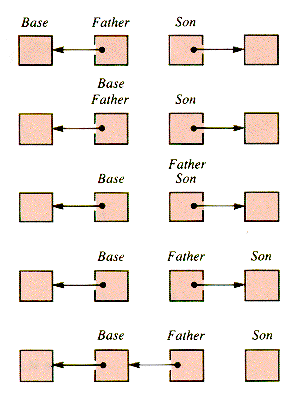
If Son  .Mark = 2 then the path leaving from Son is completely processed. The pointers are then shifted to retrace the path that led to Son, as illustrated in Figure M.3 .
.Mark = 2 then the path leaving from Son is completely processed. The pointers are then shifted to retrace the path that led to Son, as illustrated in Figure M.3 .
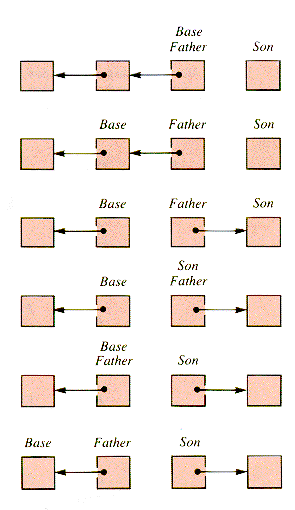
This schematic process can be generalized to nodes with n link fields by incrementing the Mark field each time one of the links leading from a node is followed. The retracing path is followed when Mark = n + 1. An abbreviated trace applied to the example of a general list given at the beginning of section 7.7 is shown in Figure M.4 .
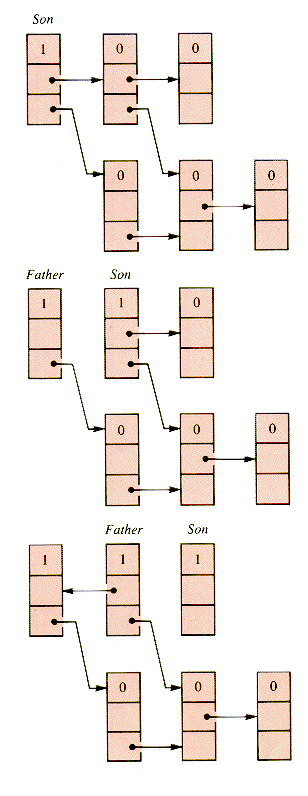
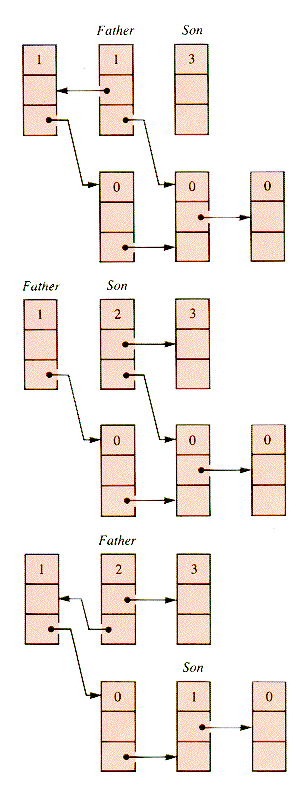
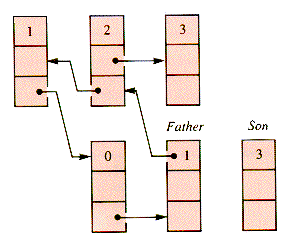
The SUE version of this scheme is:
procedure Visit(p)
FatherNIL
Sonp
repeat
kSon
.Mark
case of k
0 : PROCESS(Son)
Son.Mark
Son
.Mark + 1
1 .. n : if Son.Mark[k] = NIL
then Son.Mark
Son
.Mark + 1
else BaseFather
FatherSon
SonFather
.Link[k]
Father.Link[k]
Base
endif
n + 1 : kFather
.Mark
BaseFather
.Link[k]
Father.Link[k]
Son
SonFather
FatherBase
Son.Mark
Son
.Mark + 1
endcase
until Father = NIL
end {Visit
Projects for fun; for serious students
PJM.1 Implement and test the general visitation algorithm of this section. One way to create a general list for testing is to first place a sparse number of 1's in an N by N table T, with none on the main diagonal T[k,k]. Create an array of N nodes, each of which has N Link fields. If T[i,j] = 1, then for pointer p to node i, set p
PJM.2 A fundamental limitation of this algorithm is that the final value of p
 .Link[i] to node [j].
.Link[i] to node [j]. .Mark is n + 1, not 0. A change to modular arithmetic for the Mark field causes infinite loops. (Why?) One solution is to add a switch that causes the counting process to work with an initial mark of either 0 or n + 2. If the switch is global, it can be reset on exit from Visit so that it alternates between two values. Incorporate the necessary changes into Visit and run it. Hint: Let k
.Mark is n + 1, not 0. A change to modular arithmetic for the Mark field causes infinite loops. (Why?) One solution is to add a switch that causes the counting process to work with an initial mark of either 0 or n + 2. If the switch is global, it can be reset on exit from Visit so that it alternates between two values. Incorporate the necessary changes into Visit and run it. Hint: Let k  | p
| p  .Mark - Switch | and update p
.Mark - Switch | and update p  .Mark with a displacement that may be
.Mark with a displacement that may be  1 depending on Switch.
1 depending on Switch.